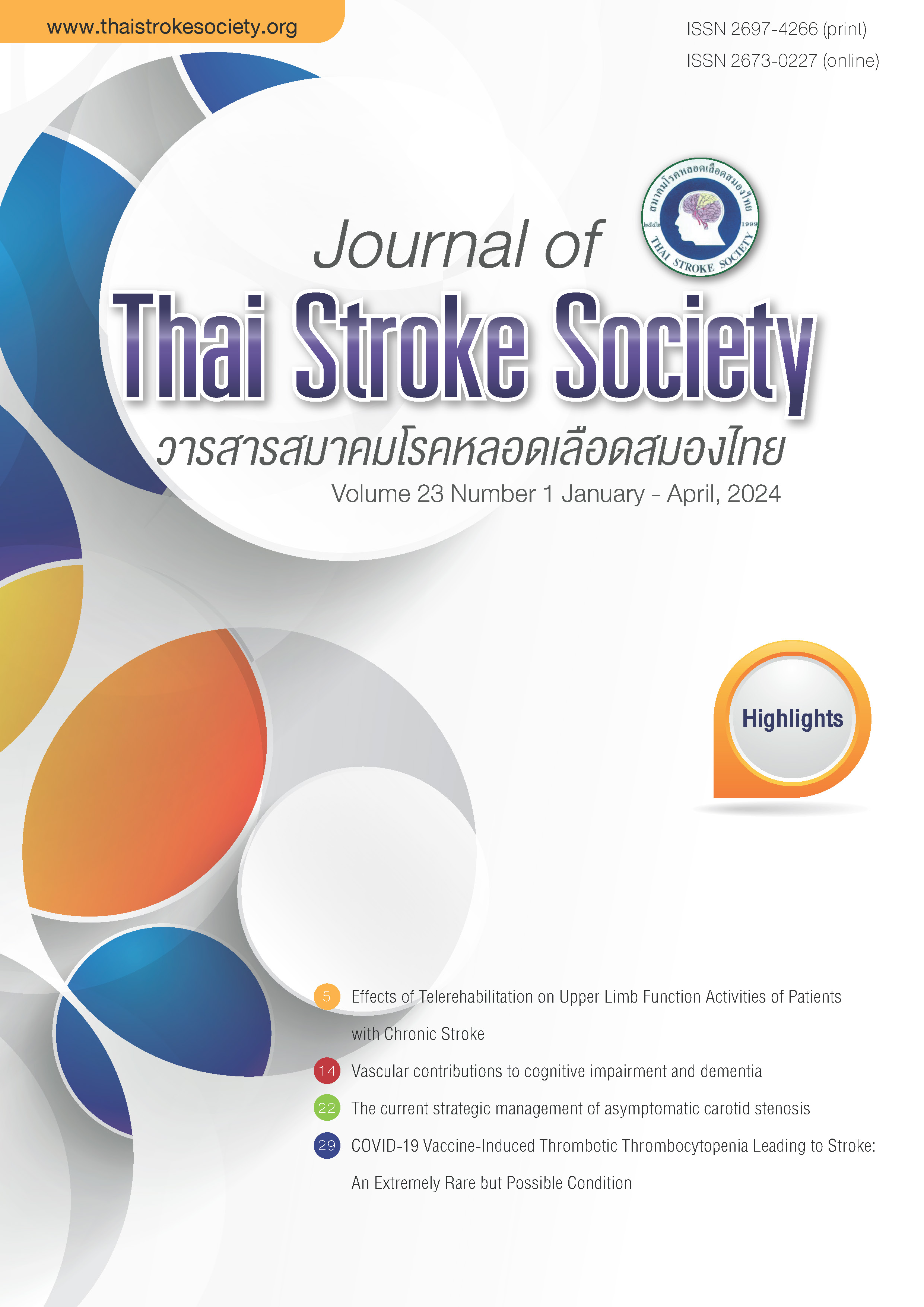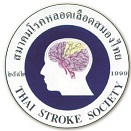Effects of Telerehabilitation on Upper Limb Function Activities of Patients with Chronic Stroke
Keywords:
Muscle Strength, Stroke, Task-Oriented Training, Telerehabilitation, Upper Limb Functional ActivitiesAbstract
This study examined the impact of telerehabilitation on upper limb functional activities (ULFA) in individuals with chronic stroke. Ten participants underwent the telerehabilitation program consisting of a 70-minute session, five times a week for four weeks. The program included a combination of strength training and task-oriented training (TOT). ULFA, grip strength, upper limb motor impairments, muscle tone and quality of life were assessed by the Streamlined Wolf Motor Function Test-Chronic (SWMFT-C), Grip strength dynamometer, Fugl-Meyer assessment of Upper extremities (FMA-UE), Modified Ashworth Scale and Stroke Impact Scale (SIS), respectively. The findings revealed statistically significant improvements (p<0.05) in SWMFT-C, grip strength, FMA-UE, and SIS scores across the strength, hand function, and percentage of recovery domains following the training program. Video-based telerehabilitation, incorporating both strength training and TOT, notably enhances ULFA and contributes to an improved quality of life for chronic stroke patients.
References
Brennan DM, Mawson S, Brownsell S. Telerehabilitation: enabling the remote delivery of healthcare, rehabilitation, and self management. Stud Health Technol Inform. 2009;145:231-48.
Rogante M, Grigioni M, Cordella D, Giacomozzi C. Ten years of telerehabilitation: A literature overview of technologies and clinical applications. NeuroRehabilitation. 2010;27(4):287-304.
Brochard S, Robertson J, Médée B, Rémy-Néris O. What’s new in new technologies for upper extremity rehabilitation. Curr Opin Neurol. 2010;23(6):683-7.
Dettmers C. Video Therapy: Promoting Hand Function after Stroke by Action Observation Training–a Pilot Randomized Controlled Trial. Int J Phys Med Rehabil. 2013;02.
กานดา ชัยภิญโญ, และสมใจ ลือวิเศษไพบูลย์. ปัญหาการขาดแคลนบุคลากรด้านกายภาพบำบัด การปฏิบัติหน้าที่แนวทางการแก้ไขปัญหา และประเด็นการปฏิรูป. เอกสารเสนอคณะกรรมาธิการการสาธารณสุข สภานิติบัญญัติแห่งชาติ.2558 [เข้าถึงเมื่อ 5 ตุลาคม 2565] เข้าถึงได้จาก http://pt.or.th/PTCouncil/file_attach/24Mar201536-AttachFile1427182476.pdf
Isariyapan O, Kerdsawatmongkon J, Chondaen N, Nualnetr N, Roongpiboonsopit D, Srisoparb W. Effects of strength training combined with task-oriented training on upper extremity recovery and enjoyment of individuals with chronic stroke. Arch AHS. 2023;35(1):58-70.
Appleby E, Gill ST, Hayes LK, Walker TL, Walsh M, Kumar S. Effectiveness of telerehabilitation in the management of adults with stroke: A systematic review. PLoS One. 2019;14(11):e0225150.
Nakayama H, Jørgensen HS, Raaschou HO, Olsen TS. Recovery of upper extremity function in stroke patients: the Copenhagen Stroke Study. Arch Phys Med Rehabil. 1994;75(4):394-8.
Srisoparb W, Nualnetr N, Sommanochai K, Karinta N, Charungthanakij P. Upper Limb Functional Ability of Individuals with Chronic Stroke in Communities of Naresuan University Hospital. Thai J Phys Ther. 2019;41(2):60-74.
Borschmann KN, Hayward KS. Recovery of upper limb function is greatest early after stroke but does continue to improve during the chronic phase: a two-year, observational study. Physiotherapy. 2020;107:216-23.
Morris DM, Uswatte G, Crago JE, Cook EW 3rd, Taub E. The reliability of the wolf motor function test for assessing upper extremity function after stroke. Arch Phys Med Rehabil. 2001;82(6):750-5.
Stark T, Walker B, Phillips JK, Fejer R, Beck R. Hand-held dynamometry correlation with the gold standard isokinetic dynamometry: a systematic review. Pm r. 2011;3(5):472-9.
Kim H, Her J, Ko J, Park D-s, Woo J-H, You Y, et al. Reliability, Concurrent Validity, and Responsiveness of the Fugl-Meyer Assessment (FMA) for Hemiplegic Patients. J. Phys. Ther. Sci. 2012;24(9):893-9.
Meseguer-Henarejos AB, Sánchez-Meca J, López-Pina JA, Carles-Hernández R. Inter- and intra-rater reliability of the Modified Ashworth Scale: a systematic review and meta-analysis. Eur J Phys Rehabil Med. 2018;54(4):576-90.
Garnjanagoonchorn A DP. Reliability and Validity of the Thai Version of the Stroke Impact Scale (SIS) 3.0. J Thai Rehabil Med. 2015;25(2):45-52.
Rozevink SG, van der Sluis CK, Garzo A, Keller T, Hijmans JM. HoMEcare aRm rehabiLItatioN (MERLIN): telerehabilitation using an unactuated device based on serious games improves the upper limb function in chronic stroke. J Neuroeng Rehabil. 2021;18(1):48.
Johansson T, Wild C. Telerehabilitation in stroke care-a systematic review. J Telemed Telecare. 2011;17(1):1-6.
Laver KE, Adey-Wakeling Z, Crotty M, Lannin NA, George S, Sherrington C. Telerehabilitation services for stroke. Cochrane Database Syst Rev. 2020;1(1):Cd010255.
Nikolaev VA, Safonicheva OG, Nikolaev AA. Telerehabilitation of Post-Stroke Patients with Motor Function Disorders: A Review. 2022;12(3):339-46.
Lin CH, Knowlton BJ, Chiang MC, Iacoboni M, Udompholkul P, Wu AD. Brain-behavior correlates of optimizing learning through interleaved practice. Neuroimage. 2011;56(3):1758-72.
Ada L, Dorsch S, Canning CG. Strengthening interventions increase strength and improve activity after stroke: a systematic review. Australian Journal of Physiotherapy. 2006;52(4):241-8.
Smith MA, Tomita MR. Combined effects of Telehealth and Modified Constraint-Induced Movement Therapy for Individuals with Chronic Hemiparesis. Int J Telerehabil. 2020;12(1):51-62.
DeJong SL, Schaefer SY, Lang CE. Need for speed: better movement quality during faster task performance after stroke. Neurorehabil Neural Repair. 2012;26(4):362-73.
Benvenuti F, Stuart M, Cappena V, Gabella S, Corsi S, Taviani A, et al. Community-based exercise for upper limb paresis: a controlled trial with telerehabilitation. Neurorehabil Neural Repair. 2014;28(7):611-20.
Downloads
Published
How to Cite
Issue
Section
License
Copyright (c) 2024 Journal of Thai Stroke Society

This work is licensed under a Creative Commons Attribution-NonCommercial-NoDerivatives 4.0 International License.
ข้อความภายในบทความที่ตีพิมพ์ในวารสารสมาคมโรคหลอดเลือดสมองไทยเล่มนี้ ตลอดจนความรับผิดชอบด้านเนื้อหาและการตรวจร่างบทความเป็นของผู้นิพนธ์ ไม่เกี่ยวข้องกับกองบรรณาธิการแต่อย่างใด การนำเนื้อหา ข้อความหรือข้อคิดเห็นของบทความไปเผยแพร่ ต้องได้รับอนุญาตจากกองบรรณาธิการอย่างเป็นลายลักษณ์อักษร ผลงานที่ได้รับการตีพิมพ์ในวารสารเล่มนี้ถือเป็นลิขสิทธิ์ของวารสาร





